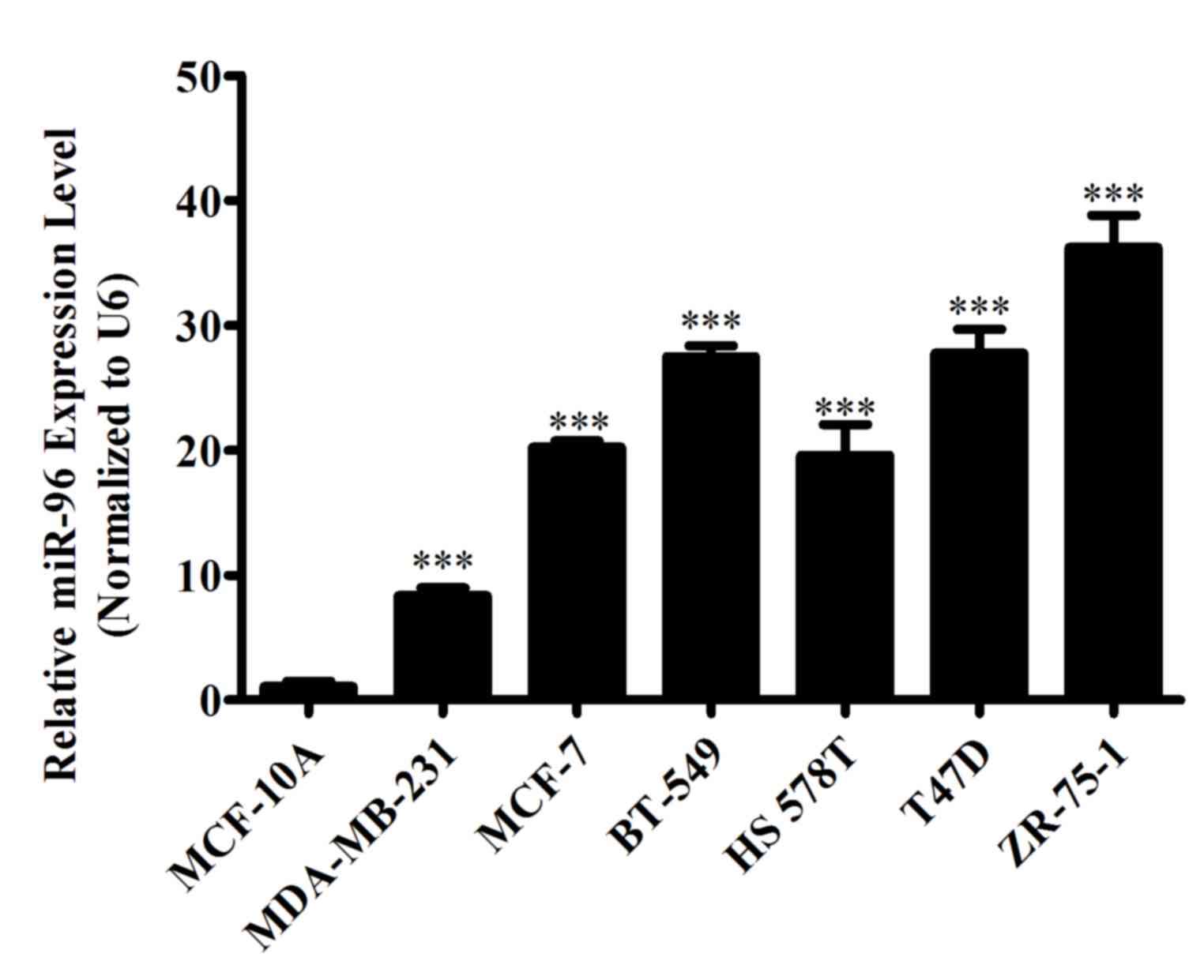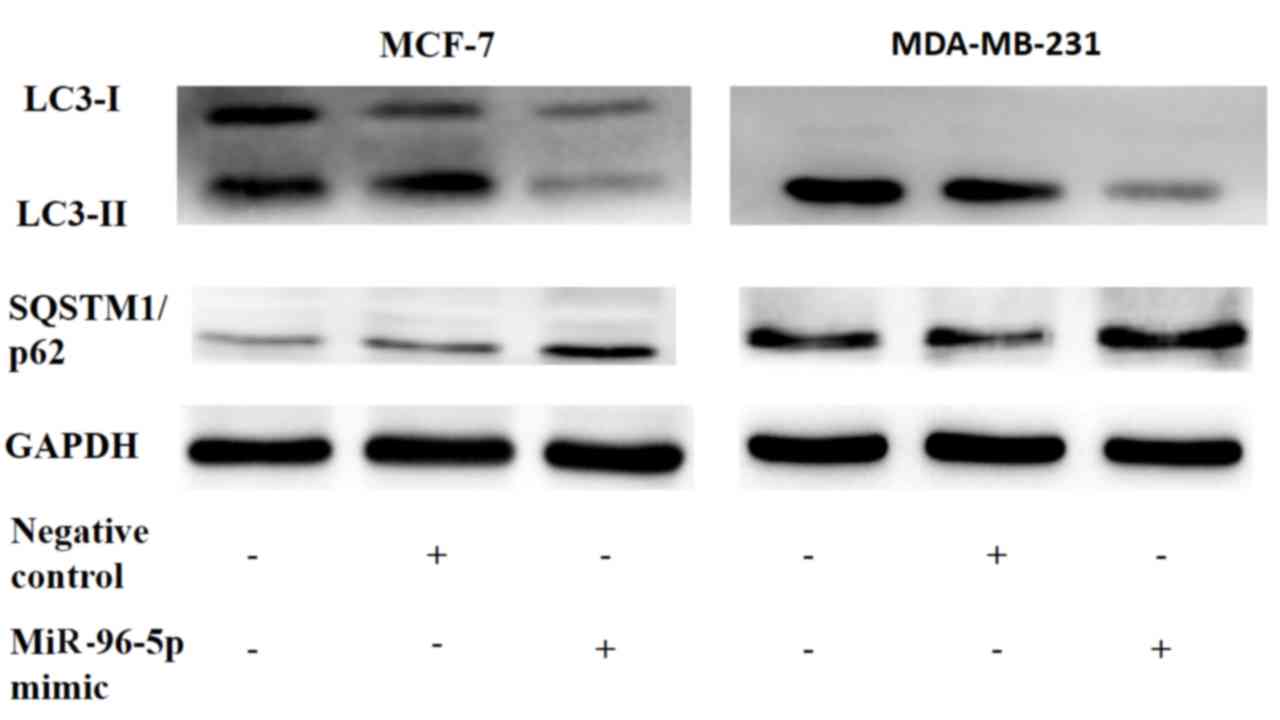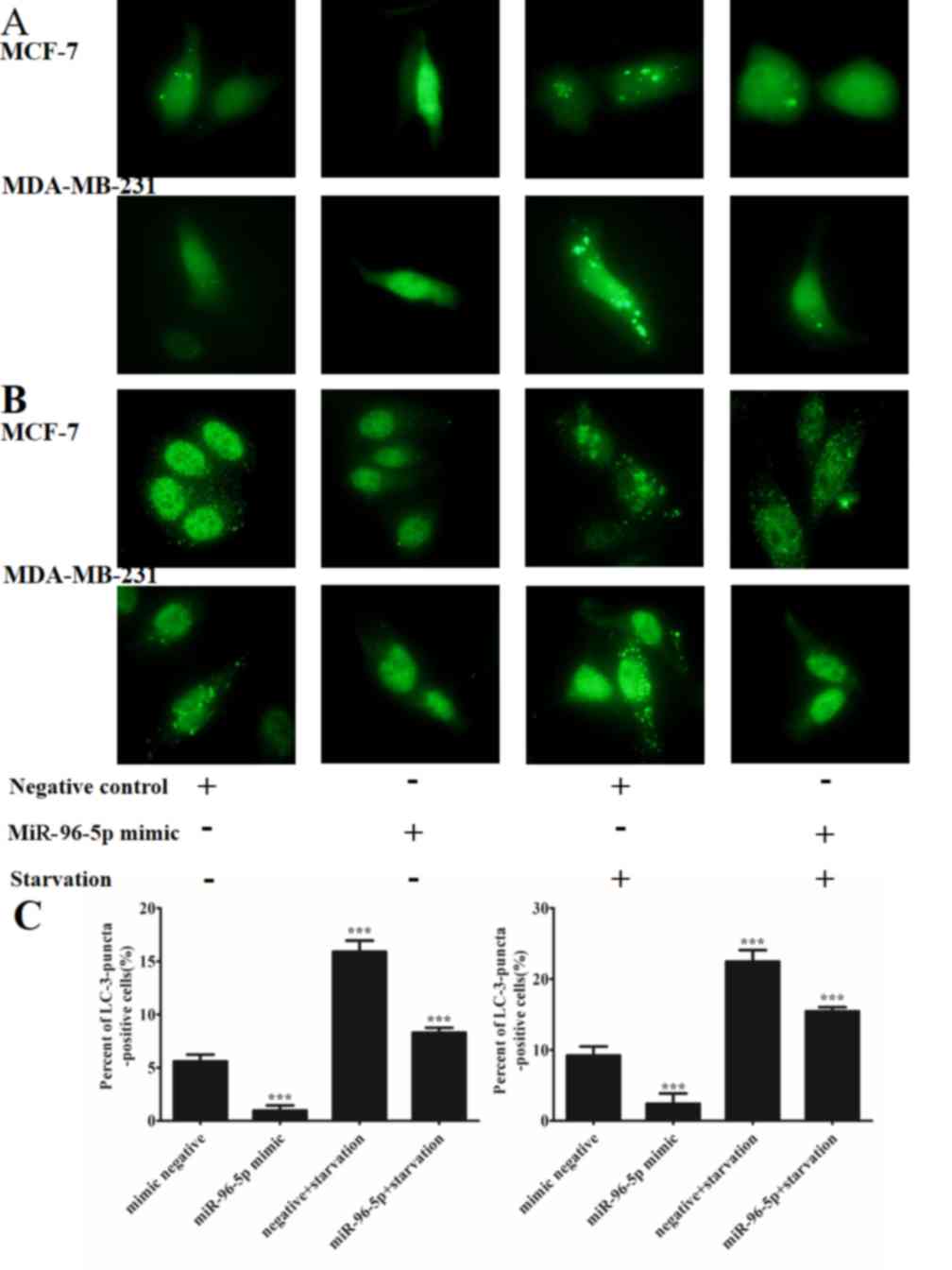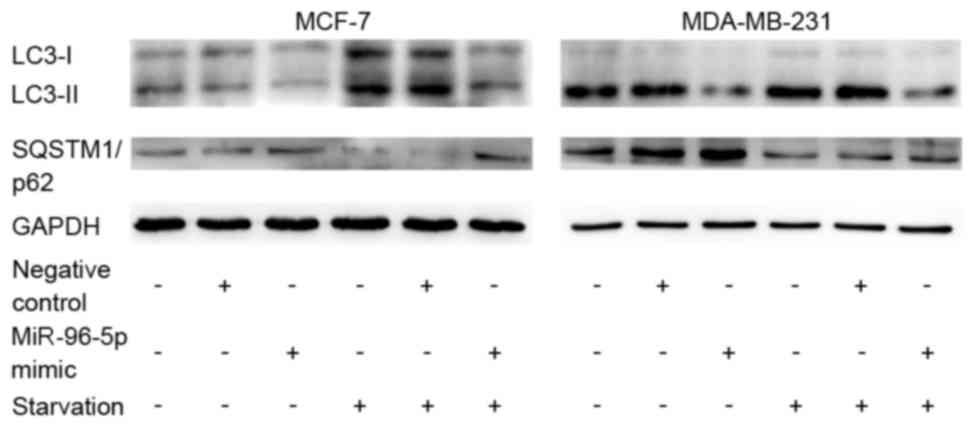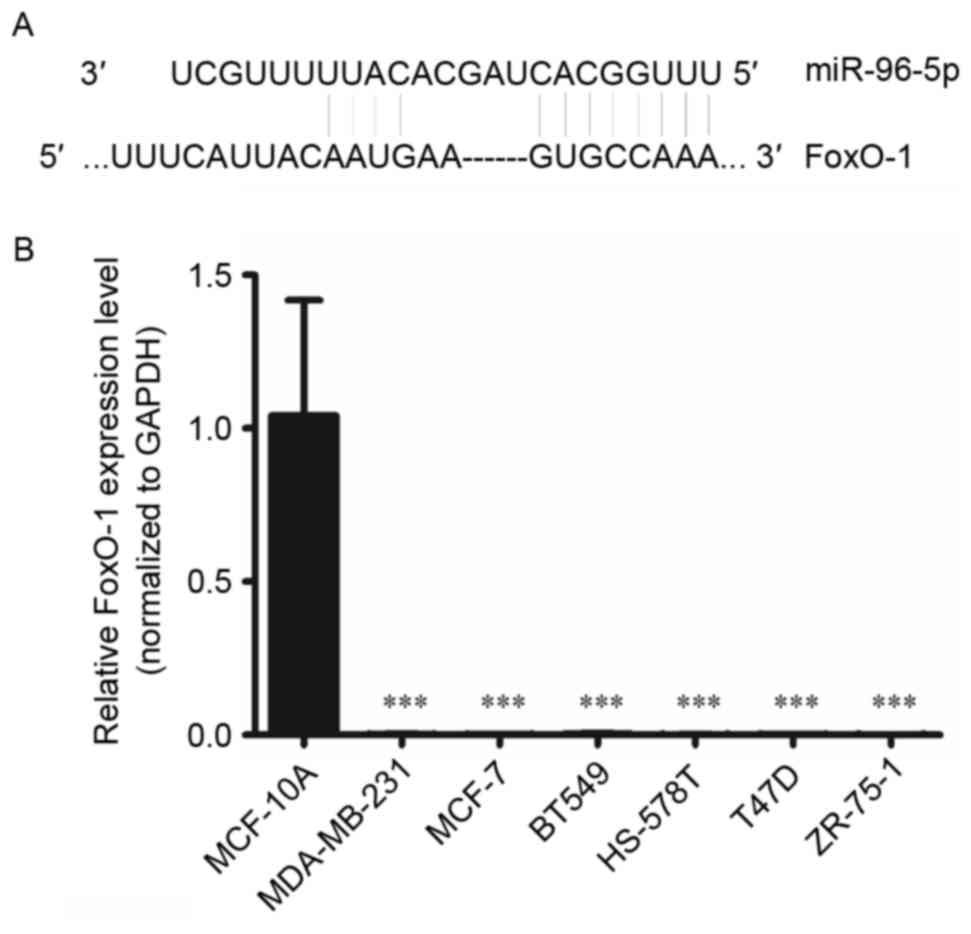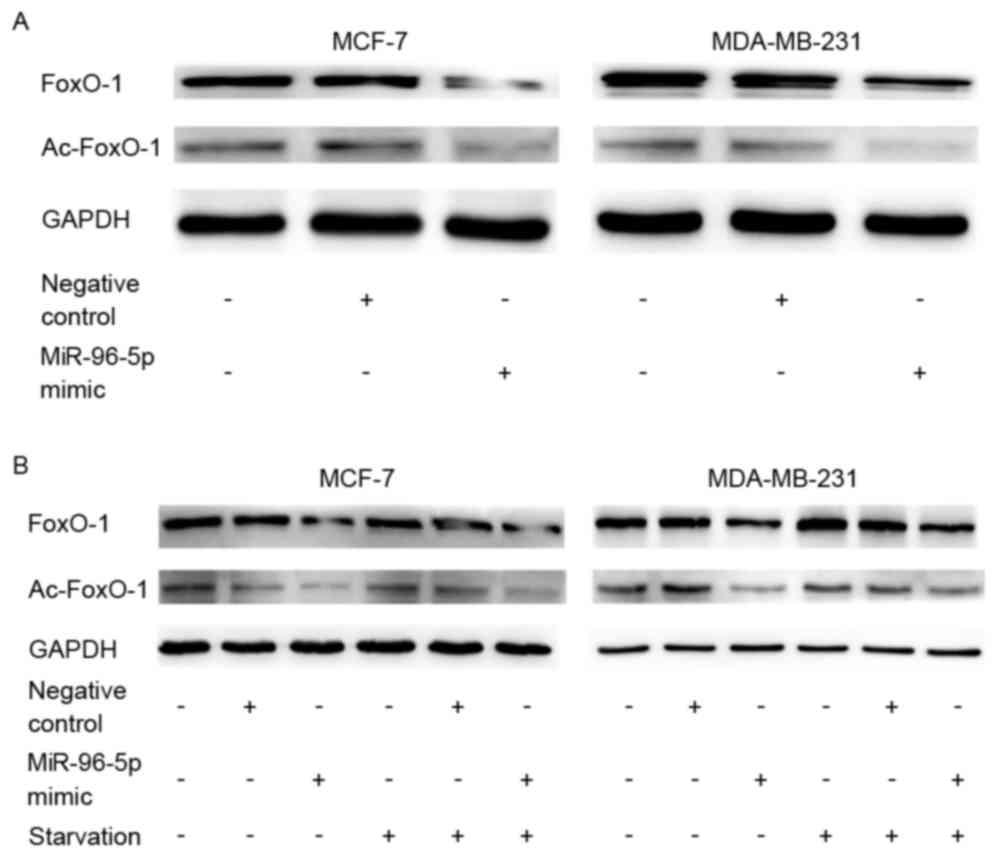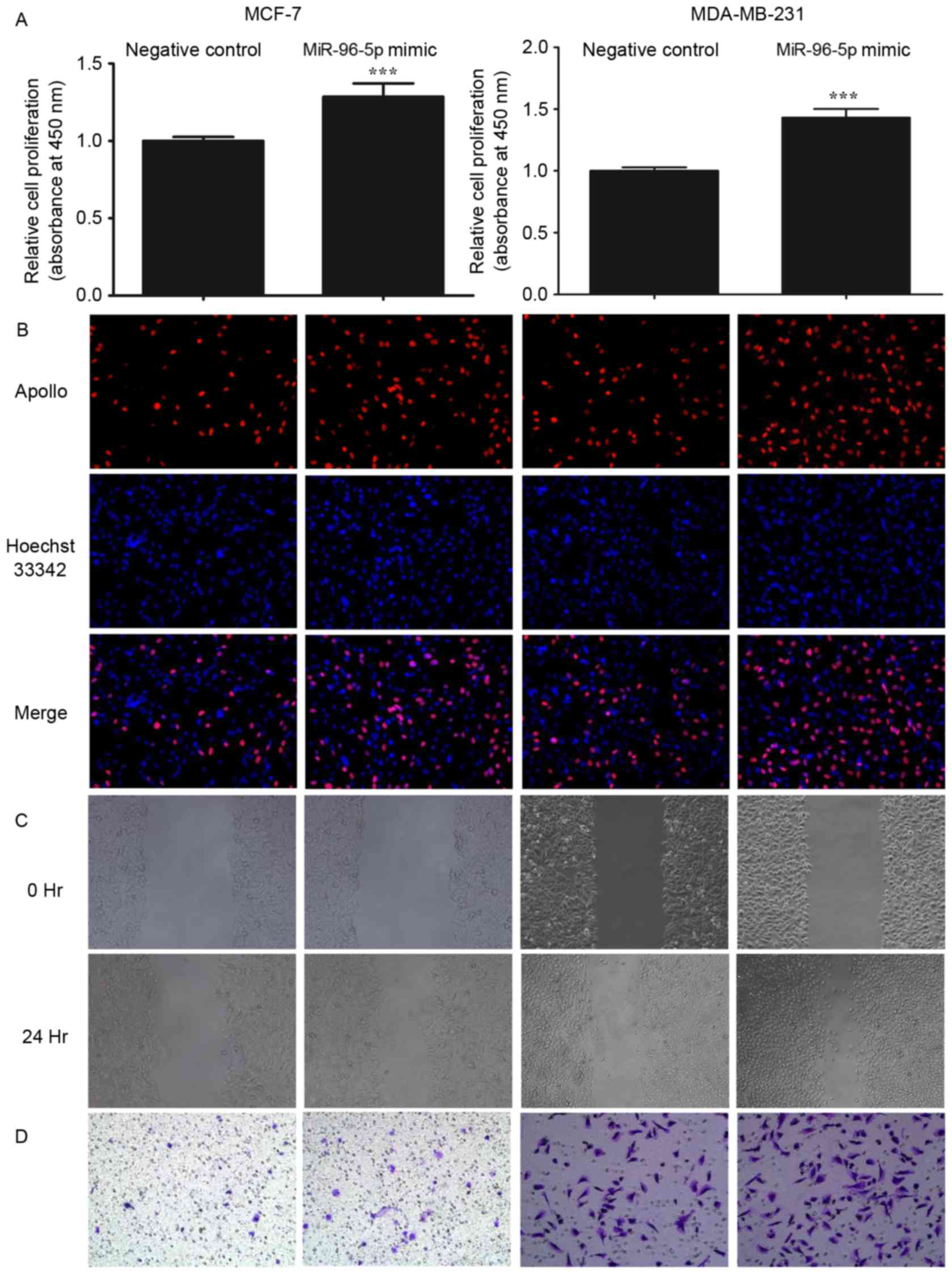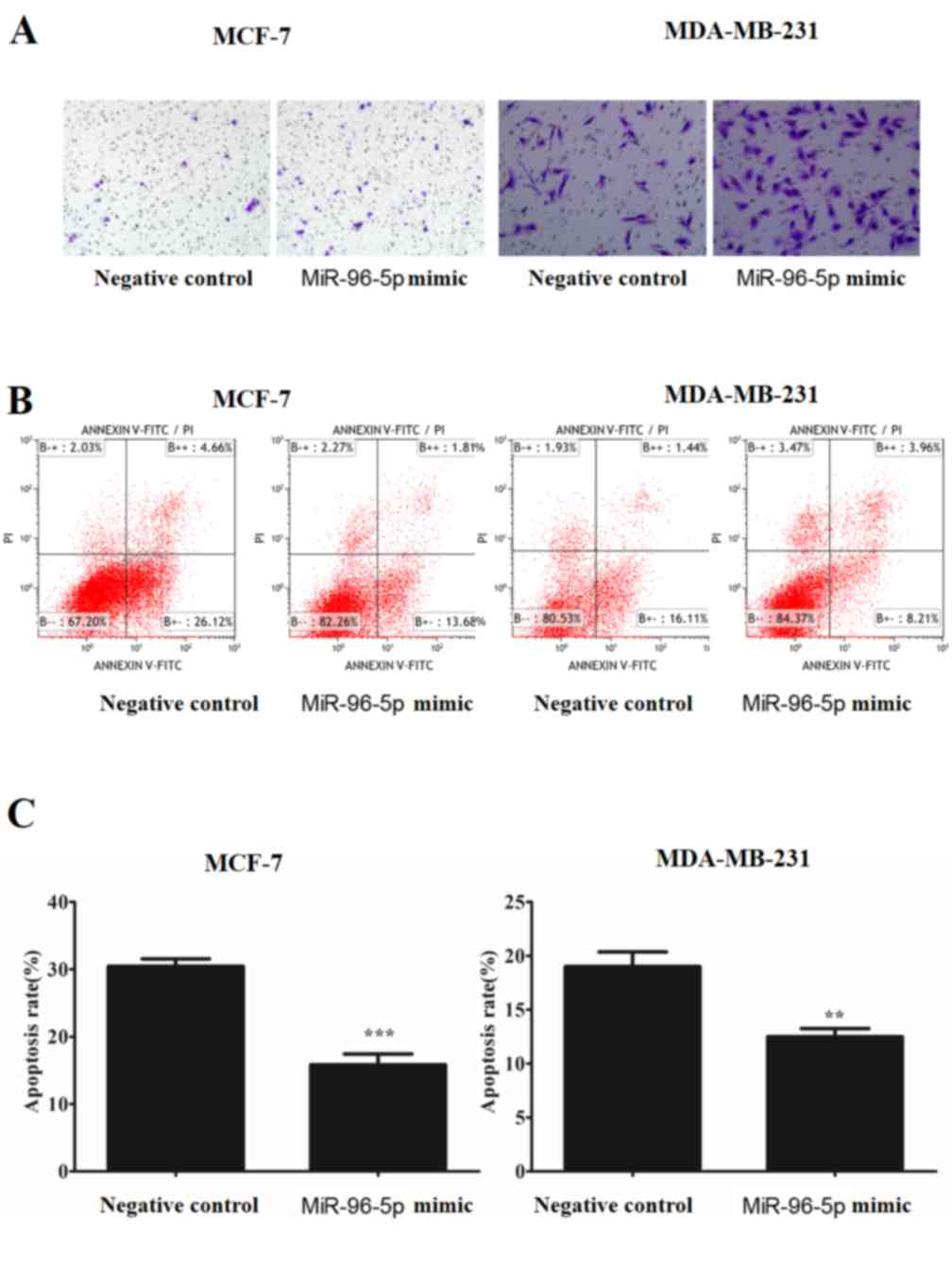Overexpression of microRNA-96-5p inhibits autophagy and apoptosis and enhances the proliferation, migration and invasiveness of human breast cancer cells
- Authors:
- Published online on: April 11, 2017 https://doi.org/10.3892/ol.2017.6025
- Pages: 4402-4412
Abstract
Introduction
Breast cancer is one of the most frequently diagnosed types of cancer and is a significant cause of mortality amongst females each year (1). In previous decades, a number of therapies have been developed to treat various types of breast cancer. However, drug resistance decreases the antitumor efficacy of treatments such as chemotherapy, endocrine therapy and targeted cancer therapy, which results in poor prognoses in certain patients. However, not all the mechanisms underlying resistance have been revealed. In previous years, increasing evidence has demonstrated that one important process is involved in the resistance against breast cancer therapies: autophagy (2,3).
Autophagy is a process that is responsible for the degradation of long-lived or abnormal proteins, and organelles that are damaged or incompetent (2–4). Under normal conditions, autophagy within cells remains at a basal level, but the process is upregulated during stressful conditions, including starvation, nutritional or hormone insufficiency, hypoxia, accumulation of metabolin and invasion by pathogens (2,5,6). The hallmarks of autophagy consist of the formation of autophagosomes, which combine with lysosomes to form autophagolysosomes. The enzymes inside the autophagolysosomes digest the contents enveloped by the cysts and then release the fragments into the cytoplasm (7,8). In studies of the molecular-biological mechanisms of autophagy, a series of genes termed autophagy-associated genes (ATG) were identified. It has also been revealed that several proteins encoded by these genes act concomitantly during autophagy and in processes that occur prior to the onset of autophagy, including autophagy-induced (ATG1, ATG13) (9–13) formation of pro-autophagosomes (ATG6, ATG16, ATG17) (13–15) and the formation of autophagosomes (ATG5, ATG7, ATG8, ATG12) (14,16–19).
Autophagy has been demonstrated to contribute to numerous types of diseases: Neurodegenerative diseases, including Alzheimer's disease (20), myocardiosis (21), pathogenic infections, including bacterial, viral and parasitic infections (22,23), and tumors. Previous studies have indicated that autophagy may exert two opposing effects within tumor cells: Autophagy may induce the development of tumors through the downregulation or deficiency of the autophagy-associated gene BECLIN1, which induces the malignant transformation of cells. Conversely, when exposed to chemotherapy or radiotherapy, autophagy may decrease the rate of apoptosis amongst tumor cells and, thus, may assist the pathogenesis of certain malignant diseases (23–26). The exact mechanism underlying autophagy-associated tumor regulation requires additional investigation.
In addition to a possible intracellular signaling mechanism, microRNAs (miR/miRNA) also serve an important role in the regulation of autophagy. miRNAs cause the instability and/or inhibition of translation of mRNAs, which leads to a decrease in target gene expression (27). A number of studies have indicated that, in stressful scenarios, a small number of miRNAs are able to regulate autophagic activity via a change in the expression level of certain specialized autophagy-associated proteins (28). In 2009, Zhu et al (28) first proposed the association between miRNA and cellular autophagy and stated that miR-30a may induce the downregulation of autophagy within tumor cells by negatively affecting the translation of BECLIN1. It was then observed that miR-181a blocks starvation- and rapamycin-induced autophagy in cancer cell lines through the regulation of the target protein ATG-5 (29). miR-376b was also revealed to regulate autophagy via targeting of the BECLIN1 gene and ATG4C (30). In addition to the aforementioned miRNAs, over one hundred studies have demonstrated evidence for the role of miRNAs in the modulation of autophagic activity.
miRNA-96 is one member of the miR-183-96-182 cluster (31–33). It was demonstrated to serve an important role in the regulation of the biological behavior of cancer cells (34–37). It is expressed at low levels within breast cancer cells and exhibits the ability to affect the translation of forkhead box protein O1 (FOXO1) and FOXO3 (34,38–41). Additionally, evidence has revealed that FOXO1 regulates autophagy (42–49). Primarily, the present study hypothesized that connections exist between miR-96 and autophagy, and that the likely target protein of this interaction is FOXO1. Therefore, in the present study, it was demonstrated that miR-96-5p blocked starvation-induced autophagy in breast cancer cell lines. It was also determined that the key protein in this process, FOXO1, is a direct autophagy-associated target of miR-96-5p.
Materials and methods
Cell culture
The human breast cancer cell lines MDA-MB-231, MCF-7, BT-549, HS 578T, T47D, and ZR-75-1 and the MCF-10A normal breast epithelial cell line were purchased from the American Type Culture Collection (Manassas, VA, USA). These cells were cultured in Dulbecco's modified Eagle's medium (DMEM; Invitrogen; Thermo Fisher Scientific, Inc., Waltham, MA, USA) supplemented with 10% fetal bovine serum (FBS; Gibco; Thermo Fisher Scientific, Inc.) and 1% penicillin/streptomycin (Gibco; Thermo Fisher Scientific, Inc.) in a 5% CO2 humidified incubator at 37°C. To induce autophagy, the cells were cultured under starvation conditions in Earle's balanced salt solution (EBSS; Gibco; Thermo Fisher Scientific, Inc.).
Reagents
Anti-light chain 3B (LC3B; cat. no. 3868; dilution, 1:1,000), FOXO1 (cat. no. 2880; dilution, 1:1,000), SQSTM1/p62 (cat. no. 5114; dilution, 1:1,000), GAPDH (cat. no. 2218 dilution, 1:1,000) antibodies and anti-rabbit IgG horseradish peroxidase-linked secondary antibody (cat. no. 7074; dilution, 1:2,000) was purchased from were obtained from Cell Signaling Technology, Inc. (Danvers, MA, USA). The acetylated-FOXO1 antibody was purchased from Santa Cruz Biotechnology, Inc. (Dallas, TX, USA). The dimethyl sulfoxide vehicle control was obtained from Sigma-Aldrich; Merck KGaA (Darmstadt, Germany). The DAPI- and fluorescein isothiocyanate (FITC)-conjugated secondary antibodies were also purchased from Sigma-Aldrich; Merck KGaA.
Plasmids and transient transfection
LC3B-EGFP was purchased from Nanjing KeyGEN BioTech, Co., Ltd. (Nanjing, China). The miR-96-5p mimic and the negative control mimic were purchased from Guangzhou RiboBio Co., Ltd (Guangzhou, China). The transient transfection of MCF-7 and MDA-MB-231 cells was performed with either Lipofectamine® RNA iMAX or Lipofectamine® 2000 (Invitrogen; Thermo Fisher Scientific, Inc.) according to the manufacturer's protocol.
RNA isolation and reverse transcription-quantitative polymerase chain reaction (RT-qPCR) analysis
Total RNA of the MCF-10A normal breast epithelial cell line and the breast cancer cell lines (MCF-7, MDA-MB-231, BT-549, HS 578T, T47D and ZR-75-1) were isolated with TRIzol® (Invitrogen; Thermo Fisher Scientific, Inc.) according to the manufacturer's protocol. cDNA was synthesized from mRNA using the PrimeScript™ RT Master mix kit (catalog no. RR036A; Takara Biotechnology, Co., Ltd., Dalian, China) and from miRNA using the One Step PrimeScript miRNA cDNA Synthesis kit (catalog no. D350; Takara Biotechnology, Co., Ltd.), according to the manufacturer's instructions. The miRNAs were converted to cDNA using TaqMan microRNA reverse transcription kit (Takara Biotechnology, Co., Ltd.). The expression levels of miR-96-5p were detected with a TaqMan microRNA kit-based quantitative PCR (Takara Biotechnology, Co., Ltd.) and normalized to the expression of small nuclear RNA, U6. The expression of FOXO1 was assessed by PCR amplification using a TaqMan RNA kit (Takara Biotechnology, Co., Ltd.). PCR was performed with the PrimeScript RT Master Mix (Takara Biotechnology, Co., Ltd.) in a Bio-Rad CFX96 real-time PCR machine (Bio-Rad Laboratories, Inc., Hercules, CA, USA). The primer sequences used for PCR were as follows: MiRNA-96-5p, forward, 5′-ACACTCCAGCTGGGTTTGGCACTAGCACATTT-3′; reverse, 5′-CTCAACTGGTGTCGTGGAGTCGGCAATTCAGTTGAGAGCAAAAA-3′; U6, forward, 5′-CTCGCTTCGGCAGCACA-3′; reverse, 5′-AACGCTTCACGAATTTGCGT-3′; FOXO1, forward, 5′-GTTGCCCAACCAAAGCTTCC-3′; reverse, 5′-TCTCAGTTCCTGCTGTCAGACAATC-3′; GAPDH, forward, 5′-AGAAGGCTGGGGCTCATTTG-3′; reverse, 5′-AGGGGCCATCCACAGTCTTC-3′. The cycling parameters for mRNA and miRNA were as follows: 95°C for 30 sec, followed by 40 cycles of 95°C for 5 sec and 60°C for 30 sec. The cycling parameters for mRNA were as follows: 95°C for 30 sec, followed by 40 cycles of 95°C for 5 sec and 60°C for 30 sec. All reactions were performed in duplicate, and the number of independent experiments (n) was marked. Data analysis was performed using the comparative ΔΔCq method with Bio-Rad Manager 2.1 software (Bio-Rad Laboratories, Inc.) (50).
Western blot analysis
MCF-7 (~105) and MDA-MB-231 (~106) cells cultured in 6-well plates were lysed in radioimmunoprecipitation assay lysis buffer (Cell Signaling Technology, Inc.) supplemented with a protease inhibitor (Roche Diagnostics, Basel, Switzerland). A total of 20 mg cell lysates were resolved by 10% SDS-PAGE and then transferred to polyvinylidene fluoride membranes. The membranes were blocked in 5% non-fat dry milk in PBST for 2 h at 25°C and incubated overnight at 4°C with the respective primary antibodies (anti-LC3B antibody, anti-SQSTM1/p62 antibody, anti-FOXO1 antibody, anti-GAPDH antibody, acetylated-FOXO1 antibody) at a dilution of 1:1,000. The membranes were washed by PBST for 3 times, and then incubated at room temperature for 1 h with the appropriate HRP-conjugated secondary antibodies as previously mentioned (Cell Signaling Technology, Inc.) and were visualized with a Plus-enhanced chemiluminescence reagent (PerkinElmer, Inc., Waltham, MA, USA), according to the manufacturer's protocol.
Immunofluorescence
For the immunofluorescence experiments, ~105 MCF-7 and MDA-MB-231 cells were grown on glass coverslips that were pre-coated with collagen and positioned in 24-well plates. The cells were incubated in a 5% CO2 humidified incubator at 37°C. The cells were transiently transfected with the miRNA mimic negative control or 50 nM miR-96-5p mimic for 24 h. The cells were then fixed in 4% paraformaldehyde, which was followed by membrane permeabilization with 0.2% Triton X-100. The cells were then blocked with 5% bovine serum albumin and incubated with an anti-LC3B antibody overnight at 4°C. Subsequently, cells were incubated with a green fluorescent protein (GFP)-tagged secondary antibody (Thermo Fisher Scientific, Inc.) or with a green fluorescent secondary antibody without GFP-tag (Thermo Fisher Scientific, Inc.) for 1 h at room temperature, followed by incubation at room temperature with DAPI (Roche Diagnostics) for 10 min. Images were captured by fluorescence microscopy (Carl Zeiss Axio Observer Z1; Carl Zeiss, Jena, Germany). The cells with >10 GFP-LC3 dots were identified as positive cells, while all others were considered negative.
Cell proliferation assay
Cell proliferation was detected using a Cell Counting kit-8 assay (CCK-8; Dojindo Molecular Technologies, Inc., Shanghai, China) and a 5-ethynyl-2′-deoxyuridine assay (EdU; RiboBio Co., Ltd.). The cells were seeded into 96-well plates at a density of 3×103 cells/well and allowed to attach overnight. The cells that were transfected with the miRNA mimic or with the negative control were then incubated with 1% FBS + DMEM for 12 h subsequent to transfection at 37°C. For the CCK-8 assay, 10 µl CCK-8 solution was added to each well, and the cells were allowed to incubate at 37°C for 1 h. The absorbance at 490 nm of each well was read on a spectrophotometer. For the EdU assay, the cells were incubated at 37°C with 50 µM EdU solution for 2 h and then fixed in 4% paraformaldehyde for 15 min. The cells were subsequently incubated at 37°C with 100 µl Apollo reagent (Thermo Fisher Scientific, Inc.) for 30 min followed by 50 µl 1% Hoechst 33,342 for 30 min. Finally, the images were captured by fluorescence microscopy. The images were analyzed using Image-Pro® Plus software 6.0 (Media Cybernetics, Inc., Rockville, MD, USA). Three independent experiments were performed in quadruplicate.
Cell migration and invasion assay
A scratch assay was performed to assess the migratory potential of the cells. The cell layer was scratched with a pipette tip when the cells reached ~95% confluence, and were then incubated under serum starvation at 37°C. The medium was changed every two days. Images were captured at ×40 magnification immediately following the generation of the scratch, at 0, 12 and 24 h subsequent to the generation of the scratch. The cell invasion assay was performed in 8 µm pore size and 6.5 mm diameter Transwell plates (Corning Life Sciences, Tewksbury, MA, USA) that were pre-coated with Matrigel® basement membrane matrix at a concentration of 1 mg/ml (BD Biosciences, Franklin Lakes, NJ, USA), according to the manufacturer's protocol. A total of 2×104 cells in 0.2 ml medium supplemented with 2% FBS were seeded into the upper chamber, and 0.6 ml medium supplemented with 10% FBS was placed in the lower chamber. The plates were incubated at 37°C in an atmosphere of 5% CO2. After 48 h, the chambers were removed and a cotton swab was used to remove the non-invading cells from the upper side of the chamber membrane. The cells on the lower membrane were then fixed in methanol for 10 min and stained with 0.1% crystal violet in 20% methanol for 30 min at room temperature.
Cell apoptosis assay
Apoptosis was assessed using an Annexin V-FITC apoptosis detection kit (Dojindo Molecular Technologies, Inc.) according to the manufacturer's protocol. The cells were transfected with the miRNA mimic or with the negative control for 12 h prior to incubation with serum-free DMEM for 48 h at 37°C. The cells were harvested, resuspended in 500 µl binding solution from the Annexin V-FITC apoptosis detection kit and incubated at room temperature with 5 µl Annexin V and 5 µl propidium iodide (PI) for 10 min in the dark. Apoptosis was analyzed by flow cytometry using a Beckman Coulter EPICS XL-MCL, and the results were analyzed by Kaluza software (Beckman Coulter Inc., Brea, CA, USA).
Accession numbers of genes mentioned in the present study
miRNA-96: Mus musculus, NCBI Gene ID: 407053; FOXO1: Mus musculus, NCBI Gene ID: 2308.
Investigation of target genes
The target genes of miRNA were investigated using a bioinformatics tool TargetScan (http://www.targetscan.org/).
Statistical analysis
The data are presented as histogram and gray intensity analysis in the results. An unpaired Student's t-test or one-way analysis of variation was used with GraphPad Prism version 5.0 (GraphPad Software Inc., La Jolla, CA, USA) to determine the differences between the treatment groups and the control groups. P<0.05 was considered to indicate a statistically significant difference.
Results
MiR-96-5p is overexpressed in breast cancer cell lines
To evaluate the differential expression of miR-96-5p in breast cancer cells and normal breast epithelial cells, RNA was extracted from the normal breast epithelial MCF-10A cell line and six distinct breast cancer cell lines, MCF-7, MDA-MB-231, BT-549, HS 578T, T47D and ZR-75-1, at the proliferating time point. The differential expression of miR-96-5p was then determined by RT-qPCR. The results demonstrated that miR-96-5p is upregulated in all breast cancer cell lines, as compared with in the normal breast cell line (Fig. 1).
Overexpression of miR-96-5p suppresses autophagy in MCF-7 and MDA-MB-231 breast cancer cells
Firstly, miR-96-5p was transiently overexpressed in MCF-7 and MDA-MB-231 breast cancer cells, and the autophagic flux was then estimated via western blot analysis (Fig. 2). This demonstrated that the elevation of miR-96-5p in breast cancer cells may repress the conversion of LC3-I to LC3-II, and that it may also block the degradation of sequestosome-M1/tumor protein 62 (SQSTM1/p62). These data confirmed an inhibitory effect of miR-96-5p on autophagy.
Overexpression of miR-96-5p suppresses starvation-induced autophagy in MCF-7 and MDA-MB-231 breast cancer cells
The present study investigated whether miR-96-5p may regulate starvation-induced autophagy. A nutrient-starvation environment was simulated via the application of EBSS for 4 h. As illustrated in Fig. 3, starvation significantly promoted autophagy (P=0.036), while the overexpression of miR-96-5p markedly repressed the accumulation of autophagic vacuoles in MCF-7 and MDA-MB-231 cells that were exposed to starvation conditions according to the GFP-LC3 transfection experiment and the immunofluorescence staining for LC3. In this section, the cells with >10 GFP-LC3 dots were identified as positive cells, while all others were considered negative. Additionally, western blotting confirmed that the conversion of LC3-I to LC3-II was inhibited whilst the degradation of SQSTM1/p62 was blocked in nutrient-starved-MCF-7 and MDA-MB-231 cells, compared with control cells (Fig. 4).
miR-96 post-transcriptionally suppresses FOXO1 via interaction with its 3′UTR
To reveal the mechanism of the regulation of autophagy by miR-96-5p, potential target genes were investigated using bioinformatics tools, including TargetScan (http://www.targetscan.org/). Through this method, FOXO1 was identified as a target gene of miR-96-5p. The interaction between miR-96-5p and the FOXO1 3′ untranslated region is illustrated in Fig. 5. To confirm this prediction, RT-qPCR was performed in the normal breast epithelial MCF-10A cell line, and in six breast cancer cell lines, MCF-7, MDA-MB-231, BT-549, HS 578T, T47D and ZR-75-1. The results demonstrated that FOXO1 mRNA levels were upregulated in MCF-10A cells, but were downregulated in all of the breast cancer cell lines tested (Fig. 5). This result was in contrast with the expression of miR-96-5p in the same types of cell lines.
miR-96 may inhibit autophagy via downregulation of the expression of FOXO1 and acetylated-FOXO1
A significant decrease was observed in FOXO1 (P=0.047) and acetylated-FOXO1 (P=0.024) protein expression levels in miR-96-5p-overexpressing cells by western blot analysis (Fig. 6). This demonstrated a tendency towards an inverse expression pattern between miR-96-5p and FOXO1. Additionally, the expression of FOXO1 and acetylated-FOXO1 demonstrated a similar trend with autophagic activities in MCF-7 and MDA-MB-231 cell lines that were cultured under starvation conditions (Fig. 6). Considering the previous reports, it is hypothesized that FOXO1 may be a target of miR-96-5p and may inhibit autophagy.
miR-96-5p promotes proliferation, migration and invasion, but suppresses apoptosis in MCF-7 and MDA-MB-231 cells
To examine the effect of miR-96-5p on the malignant biological processes in breast cancer cells, including cell proliferation, migration and invasion, miR-96-5p was overexpressed via the transfection of MCF-7 and MDA-MB-231 cells with a miR-96-5p mimic or a control construct. CCK-8 and EdU assays were then performed to evaluate the level of proliferation; scratch, Transwell and Matrigel invasion assays were used to analyze migration and invasion. As presented in Figs. 7 and 8, it was demonstrated that the overexpression of miR-96-5p significantly promoted cell proliferation, migration and invasion (P<0.001). Additionally, the transfected cells were treated and incubated without serum for 24–48 h and then stained with Annexin V and PI; the apoptotic cells were subsequently quantified by flow cytometry. The overexpression of miR-96-5p significantly inhibited the rate of apoptosis of MCF-7 (P<0.001) and MDA-MB-231 cells (P<0.005) (Fig. 8).
Discussion
miRNAs are a series of small RNAs that may affect biological features through the regulation of the expression of their target genes (51). In previous studies, it was demonstrated that miR-96 is involved in several types of cancer, including breast cancer, and contributes to cancer progression (37,52–55). Therefore, miRNAs are considered potential therapeutic targets in cancer. In the present study, it was demonstrated that miR-96-5p is overexpressed in breast cancer cell lines and that this overexpression of miR-96-5p enhances the proliferation, migration and invasiveness of these breast cancer cells. In addition, it was revealed that the overexpression of miR-96 leads to the inhibition of apoptosis. Therefore, it was confirmed that miR-96-5p may promote the progression of breast cancer in a ‘traditional’ manner.
Additionally, autophagy is an important biological feature that occurs in cells. Autophagy is another form of programmed cell death that differs from apoptosis, in which cells undergo self-digestion with increased autophagosome formation (8,9,56). Autophagy and apoptosis affect the rate cell death by parallel pathways under certain conditions (57). However, previous studies have demonstrated that autophagy serves as a pro-survival response to several stressors, including starvation, hypoxia, radiation and chemotherapy, particularly in tumor cells (25,53–55,58–61). Autophagy may have antitumor or pro-tumor functions, and is thus considered to be a ‘double-edged sword’ in the field of oncology (25,53–55,58–61). In breast cancer, autophagy may mitigate metabolic stress and genomic damage in mammary tumorigenesis (5). Additionally, previous studies have demonstrated that the upregulation of autophagy assists cancer cells to survive common breast cancer therapies, including tamoxifen, trastuzumab, anthracycline, taxane, temozolomide and radiotherapy, amongst others, which may markedly affect the prognosis of patients (60–70). Additionally, the inhibition of autophagy increases drug sensitivity, such that chloroquine may restore sensitivity to trastuzumab in HER2-positive breast cancer (62,64).
The aforementioned data suggest that the combination of autophagy inhibition and cancer therapy, particularly targeted therapy based on miRNAs, may serve as an effective approach for the treatment of tumors.
In the present study, miR-96-5p was introduced as an autophagy-associated miRNA. The overexpression of miR-96-5p inhibited GFP-LC3 dot formation, fluorescent LC3B accumulation, the conversion of LC3-I to LC3-II and SQSTM1/p62 degradation. These are markers of the initiation of standard and starvation-induced autophagy, which is considered to be the classical and most effective method of stimulating autophagy (71), in two breast cancer cell lines, MCF-7 and MDA-MB-231. Therefore, these data demonstrated that miR-96-5p is a key miRNA that regulates autophagy in breast cancer cells.
The present study aimed to determine the association between miR-96-5p and autophagy. According to the prediction generated by TargetScan, a notable transcription factor, FOXO1, was observed as one of the target genes of miR-96-5p. FOXO1 is a member of the forkhead transcription factors of the O class family (FOXO) that includes FOXO1 (FKHR), FOXO-3 (FKHRL1), FOXO-4 (AFX) and FOXO-6. FOXO1 regulates the biological behavior of tumor cells, including apoptosis, differentiation and oxidative stimulation through the phosphoinositide 3-kinase and protein kinase B signaling pathways (72,73). Guttilla et al (37) demonstrated that miR-96 was overexpressed in breast cancer cell lines, and that it downregulated the expression of FOXO1. Guo et al (74) and Haflidadóttir et al (75) suggested that miR-96 regulates FOXO1-mediated cell apoptosis and proliferation in prostate cancer. The association between FOXO1 and autophagy in multiple types of cancer, including bladder transitional cell carcinoma, prostate cancer and endometrial carcinoma, was identified in recent years (42–44,47,48,66,76). Hariharan et al (47) demonstrated that the deacetylation of FOXO1 by Sirtuin 1 serves a key role in the mediation of starvation-induced autophagy in cardiac myocytes. In a series of articles by Zhao et al (44,48,77), it was noted that cytosolic FOXO1 combined with ATG5 is essential for cancer cell autophagy, and may be suppressed by unspliced X-box protein-1 and induced by FOXO3 in varying conditions.
In the present study, it was determined that the expression of FOXO1 mRNA was lower in the breast cancer cell lines, as compared with in the normal breast epithelial cell line, but that the expression of miR-96-5p was high in the breast cancer cell lines. The overexpression of miR-96-5p significantly inhibited the expression of FOXO1 and acetylated-FOXO1; this effect was also observed under starvation-induced conditions together with the inhibition of autophagy activation in the two breast cancer cell lines MDA-MB 231 and MCF-7.
Considering the results of previous studies, it is reasonable to predict that miR-96-5p may regulate the activation of autophagy in breast cancer cells through the target protein, FOXO1. During the preparation of this manuscript, Ma et al (78) published an article that hypothesized a biphasic regulation of autophagy by miR-96 in prostate cancer cells in hypoxic conditions. These data suggests that there may be an expression level threshold of miR-96 in certain situations, including hypoxia, and on either side of this threshold the miR-96 may have the opposite effect. Therefore, additional studies are required to explore the mechanisms underlying the regulation of miR-96 and FOXO1-associated autophagy in breast cancer.
In conclusion, the present study demonstrated that miR-96-5p is overexpressed in breast cancer cells. The upregulation of miR-96-5p enhances proliferation, migration and invasion, but inhibits apoptosis. Notably, the overexpression of miR-96-5p may suppress standard and starvation-induced autophagy in breast cancer cells, which is most likely to be regulated by FOXO1. Therefore, miR-96-5p is an important molecule in the study of chemotherapeutic sensitivity and tolerance, and it may become a potential therapeutic target in patients with breast cancer.
References
|
Libson S and Lippman M: A review of clinical aspects of breast cancer. Int Rev Psychiatry. 26:4–15. 2014. View Article : Google Scholar : PubMed/NCBI | |
|
White E and Dipaola RS: The double-edged sword of autophagy modulation in cancer. Clin Cancer Res. 15:5308–5316. 2009. View Article : Google Scholar : PubMed/NCBI | |
|
Kamada Y, Sekito T and Ohsumi Y: Autophagy in yeast: A TOR-mediated response to nutrient starvation. Curr Top Microbiol Immunol. 279:73–84. 2004.PubMed/NCBI | |
|
Krustev LP: Cell autophagy of the liver in starvation and undernutrition. Bibl Nutr Dieta. 145–154. 1976.PubMed/NCBI | |
|
Karantza-Wadsworth V, Patel S, Kravchuk O, Chen G, Mathew R, Jin S and White E: Autophagy mitigates metabolic stress and genome damage in mammary tumorigenesis. Genes Dev. 21:1621–1635. 2007. View Article : Google Scholar : PubMed/NCBI | |
|
Chera S, Buzgariu W, Ghila L and Galliot B: Autophagy in hydra: A response to starvation and stress in early animal evolution. Biochim Biophys Acta. 1793:1432–1443. 2009. View Article : Google Scholar : PubMed/NCBI | |
|
Klionsky DJ, Abdalla FC, Abeliovich H, Abraham RT, Acevedo-Arozena A, Adeli K, Agholme L, Agnello M, Agostinis P, Aguirre-Ghiso JA, et al: Guidelines for the use and interpretation of assays for monitoring autophagy. Autophagy. 8:445–544. 2012. View Article : Google Scholar : PubMed/NCBI | |
|
Mizushima N, Ohsumi Y and Yoshimori T: Autophagosome formation in mammalian cells. Cell Struct Funct. 27:421–429. 2002. View Article : Google Scholar : PubMed/NCBI | |
|
De Duve C and Wattiaux R: Functions of lysosomes. Annu Rev Physiol. 28:435–492. 1966. View Article : Google Scholar : PubMed/NCBI | |
|
Noda T, Suzuki K and Ohsumi Y: Yeast autophagosomes: De novo formation of a membrane structure. Trends Cell Biol. 12:231–235. 2002. View Article : Google Scholar : PubMed/NCBI | |
|
Kabeya Y, Kamada Y, Baba M, Takikawa H, Sasaki M and Ohsumi Y: Atg17 functions in cooperation with Atg1 and Atg13 in yeast autophagy. Mol Biol Cell. 16:2544–2553. 2005. View Article : Google Scholar : PubMed/NCBI | |
|
Reggiori F, Tucker KA, Stromhaug PE and Klionsky DJ: The Atg1-Atg13 complex regulates Atg9 and Atg23 retrieval transport from the pre-autophagosomal structure. Dev Cell. 6:79–90. 2004. View Article : Google Scholar : PubMed/NCBI | |
|
Kabeya Y, Kamada Y, Baba M, Takikawa H, Sasaki M and Ohsumi Y: Atg17 functions in cooperation with Atg1 and Atg13 in yeast autophagy. Mol Biol Cell. 16:2544–2553. 2005. View Article : Google Scholar : PubMed/NCBI | |
|
Matsushita M, Suzuki NN, Obara K, Fujioka Y, Ohsumi Y and Inagaki F: Structure of Atg5. Atg16, a complex essential for autophagy. J Biol Chem. 282:6763–6772. 2007. View Article : Google Scholar : PubMed/NCBI | |
|
Matsushita M, Suzuki NN, Fujioka Y, Ohsumi Y and Inagaki F: Expression, purification and crystallization of the Atg5-Atg16 complex essential for autophagy. Acta Crystallogr Sect F Struct Biol Cryst Commun. 62:1021–1023. 2006. View Article : Google Scholar : PubMed/NCBI | |
|
Liang XH, Jackson S, Seaman M, Brown K, Kempkes B, Hibshoosh H and Levine B: Induction of autophagy and inhibition of tumorigenesis by beclin 1. Nature. 402:672–676. 1999. View Article : Google Scholar : PubMed/NCBI | |
|
Codogno P and Meijer AJ: Atg5: More than an autophagy factor. Nat Cell Biol. 8:1045–1047. 2006. View Article : Google Scholar : PubMed/NCBI | |
|
Fujioka Y, Noda NN, Fujii K, Yoshimoto K, Ohsumi Y and Inagaki F: In vitro reconstitution of plant Atg8 and Atg12 conjugation systems essential for autophagy. J Biol Chem. 283:1921–1928. 2008. View Article : Google Scholar : PubMed/NCBI | |
|
Nishino I: Autophagic vacuolar myopathies. Curr Neurol Neurosci Rep. 3:64–69. 2003. View Article : Google Scholar : PubMed/NCBI | |
|
Rubinsztein DC, Difiglia M, Heintz N, Nixon RA, Qin ZH, Ravikumar B, Stefanis L and Tolkovsky A: Autophagy and its possible roles in nervous system diseases, damage and repair. Autophagy. 1:11–22. 2005. View Article : Google Scholar : PubMed/NCBI | |
|
Nakai A, Yamaguchi O, Takeda T, Higuchi Y, Hikoso S, Taniike M, Omiya S, Mizote I, Matsumura Y, Asahi M, et al: The role of autophagy in cardiomyocytes in the basal state and in response to hemodynamic stress. Nat Med. 13:619–624. 2007. View Article : Google Scholar : PubMed/NCBI | |
|
Miller S and Krijnse-Locker J: Modification of intracellular membrane structures for virus replication. Nat Rev Microbiol. 6:363–374. 2008. View Article : Google Scholar : PubMed/NCBI | |
|
Nakagawa I, Amano A, Mizushima N, Yamamoto A, Yamaguchi H, Kamimoto T, Nara A, Funao J, Nakata M, Tsuda K, et al: Autophagy defends cells against invading group A streptococcus. Science. 306:1037–1040. 2004. View Article : Google Scholar : PubMed/NCBI | |
|
Kubisch J, Türei D, Földvári-Nagy L, Dunai ZA, Zsákai L, Varga M, Vellai T, Csermely P and Korcsmáros T: Complex regulation of autophagy in cancer - Integrated approaches to discover the networks that hold a double-edged sword. Semin Cancer Biol. 23:252–261. 2013. View Article : Google Scholar : PubMed/NCBI | |
|
Lorin S, Hamaï A, Mehrpour M and Codogno P: Autophagy regulation and its role in cancer. Semin Cancer Biol. 23:361–379. 2013. View Article : Google Scholar : PubMed/NCBI | |
|
Liu B, Wen X and Cheng Y: Survival or death: Disequilibrating the oncogenic and tumor suppressive autophagy in cancer. Cell Death Dis. 4:e8922013. View Article : Google Scholar : PubMed/NCBI | |
|
Ambros V: The functions of animal microRNAs. Nature. 431:350–355. 2004. View Article : Google Scholar : PubMed/NCBI | |
|
Zhu H, Wu H, Liu X, Li B, Chen Y, Ren X, Liu CG and Yang JM: Regulation of autophagy by a beclin 1-targeted microRNA, miR-30a, in cancer cells. Autophagy. 5:816–823. 2009. View Article : Google Scholar : PubMed/NCBI | |
|
Tekirdag KA, Korkmaz G, Ozturk DG, Agami R and Gozuacik D: MIR181A regulates starvation- and rapamycin-induced autophagy through targeting of ATG5. Autophagy. 9:374–385. 2013. View Article : Google Scholar : PubMed/NCBI | |
|
Korkmaz G, le Sage C, Tekirdag KA, Agami R and Gozuacik D: MiR-376b controls starvation and mTOR inhibition-related autophagy by targeting ATG4C and BECN1. Autophagy. 8:165–176. 2012. View Article : Google Scholar : PubMed/NCBI | |
|
Sacheli R, Nguyen L, Borgs L, Vandenbosch R, Bodson M, Lefebvre P and Malgrange B: Expression patterns of miR-96, miR-182 and miR-183 in the development inner ear. Gene Expr Patterns. 9:364–370. 2009. View Article : Google Scholar : PubMed/NCBI | |
|
Zhu W, Liu X, He J, Chen D, Hunag Y and Zhang YK: Overexpression of members of the microRNA-183 family is a risk factor for lung cancer: A case control study. BMC Cancer. 11:3932011. View Article : Google Scholar : PubMed/NCBI | |
|
Mihelich BL, Khramtsova EA, Arva N, Vaishnav A, Johnson DN, Giangreco AA, Martens-Uzunova E, Bagasra O, Kajdacsy-Balla A and Nonn L: MiR-183-96-182 cluster is overexpressed in prostate tissue and regulates zinc homeostasis in prostate cells. J Biol Chem. 286:44503–44511. 2011. View Article : Google Scholar : PubMed/NCBI | |
|
Fendler A, Jung M, Stephan C, Erbersdobler A, Jung K and Yousef GM: The antiapoptotic function of miR-96 in prostate cancer by inhibition of FOXO1. PLoS One. 8:e808072013. View Article : Google Scholar : PubMed/NCBI | |
|
Yu S, Lu Z, Liu C, Meng Y, Ma Y, Zhao W, Liu J, Yu J and Chen J: MiRNA-96 suppresses KRAS and functions as a tumor suppressor gene in pancreatic cancer. Cancer Res. 70:6015–6025. 2010. View Article : Google Scholar : PubMed/NCBI | |
|
Lin H, Dai T, Xiong H, Zhao X, Chen X, Yu C, Li J, Wang X and Song L: Unregulated miR-96 induces cell proliferation in human breast cancer by downregulating transcriptional factor FOXO3a. PLoS One. 5:e157972010. View Article : Google Scholar : PubMed/NCBI | |
|
Guttilla IK and White BA: Coordinate regulation of FOXO1 by miR-27a, miR-96 and miR-182 in breast cancer cells. J Biol Chem. 284:23204–23216. 2009. View Article : Google Scholar : PubMed/NCBI | |
|
Li J, Li P, Chen T, Gao G, Chen X, Du Y, Zhang R, Yang R, Zhao W, Dun S, et al: Expression of microRNA-96 and its potential functions by targeting FOXO3 in non-small cell lung cancer. Tumour Biol. 36:685–692. 2015. View Article : Google Scholar : PubMed/NCBI | |
|
Kundu ST, Byers LA, Peng DH, Roybal JD, Diao L, Wang J, Tong P, Creighton CJ and Gibbons DL: The miR-200 family and the miR-183~96~182 cluster target Foxf2 to inhibit invasion and metastasis in lung cancers. Oncogene. 35:173–186. 2016. View Article : Google Scholar : PubMed/NCBI | |
|
Yu JJ, Wu YX, Zhao FJ and Xia SJ: MiR-96 promotes cell proliferation and clonogenicity by down-regulating of FOXO1 in prostate cancer cells. Med Oncol. 31:9102014. View Article : Google Scholar : PubMed/NCBI | |
|
Haflidadóttir BS, Larne O, Martin M, Persson M, Edsjö A, Bjartell A and Ceder Y: Upregulation of miR-96 enhances cellular proliferation of prostate cancer cells through FOXO1. PLoS One. 8:e724002013. View Article : Google Scholar : PubMed/NCBI | |
|
Zhou J, Liao W, Yang J, Ma K, Li X, Wang Y, Wang D, Wang L, Zhang Y, Yin Y, et al: FOXO3 induces FOXO1-dependent autophagy by activating the AKT1 signaling pathway. Autophagy. 8:1712–1723. 2012. View Article : Google Scholar : PubMed/NCBI | |
|
Vidal RL and Hetz C: Unspliced XBP1 controls autophagy through FoxO1. Cell Res. 23:463–464. 2013. View Article : Google Scholar : PubMed/NCBI | |
|
Zhao Y, Li X, Cai MY, Ma K, Yang J, Zhou J, Fu W, Wei FZ, Wang L, Xie D and Zhu WG: XBP-1u suppresses autophagy by promoting the degradation of FoxO1 in cancer cells. Cell Res. 23:491–507. 2013. View Article : Google Scholar : PubMed/NCBI | |
|
Xiao D, Bommareddy A, Kim SH, Sehrawat A, Hahm ER and Singh SV: Benzyl isothiocyanate causes FoxO1-mediated autophagic death in human breast cancer cells. PLoS One. 7:e325972012. View Article : Google Scholar : PubMed/NCBI | |
|
van der Vos KE, Eliasson P, Proikas-Cezanne T, Vervoort SJ, van Boxtel R, Putker M, van Zutphen IJ, Mauthe M, Zellmer S, Pals C, et al: Modulation of glutamine metabolism by the PI(3)K-PKB-FOXO network regulates autophagy. Nat Cell Biol. 14:829–837. 2012. View Article : Google Scholar : PubMed/NCBI | |
|
Hariharan N, Maejima Y, Nakae J, Paik J, Depinho RA and Sadoshima J: Deacetylation of FoxO by Sirt1 plays an essential role in mediating starvation-induced autophagy in cardiac myocytes. Circ Res. 107:1470–1482. 2010. View Article : Google Scholar : PubMed/NCBI | |
|
Zhao Y, Yang J, Liao W, Liu X, Zhang H, Wang S, Wang D, Feng J, Yu L and Zhu WG: Cytosolic FoxO1 is essential for the induction of autophagy and tumour suppressor activity. Nat Cell Biol. 12:665–675. 2010. View Article : Google Scholar : PubMed/NCBI | |
|
Liu HY, Han J, Cao SY, Hong T, Zhuo D, Shi J, Liu Z and Cao W: Hepatic autophagy is suppressed in the presence of insulin resistance and hyperinsulinemia: inhibition of FoxO1-dependent expression of key autophagy genes by insulin. J Biol Chem. 284:31484–31492. 2009. View Article : Google Scholar : PubMed/NCBI | |
|
Livak KJ and Schmittgen TD: Analysis of relative gene expression data using real-time quantitative PCR and the 2(−Delta Delta C(T)) Method. Methods. 25:402–408. 2001. View Article : Google Scholar : PubMed/NCBI | |
|
Krützfeldt J and Stoffel M: MicroRNAs: A new class of regulatory genes affecting metabolism. Cell Metab. 4:9–12. 2006. View Article : Google Scholar : PubMed/NCBI | |
|
Xu XM, Qian JC, Deng ZL, Cai Z, Tang T, Wang P, Zhang KH and Cai JP: Expression of miR-21, miR-31, miR-96 and miR-135b is correlated with the clinical parameters of colorectal cancer. Oncol Lett. 4:339–345. 2012.PubMed/NCBI | |
|
Levine B and Kroemer G: Autophagy in the pathogenesis of disease. Cell. 132:27–42. 2008. View Article : Google Scholar : PubMed/NCBI | |
|
Sun WL, Chen J, Wang YP and Zheng H: Autophagy protects breast cancer cells from epirubicin-induced apoptosis and facilitates epirubicin-resistance development. Autophagy. 7:1035–1044. 2011. View Article : Google Scholar : PubMed/NCBI | |
|
White E and DiPaola RS: The double-edged sword of autophagy modulation in cancer. Clin Cancer Res. 15:5308–5316. 2009. View Article : Google Scholar : PubMed/NCBI | |
|
Kang C and Avery L: To be or not to be, the level of autophagy is the question: Dual roles of autophagy in the survival response to starvation. Autophagy. 4:82–84. 2008. View Article : Google Scholar : PubMed/NCBI | |
|
Boya P, Reggiori F and Codogno P: Emerging regulation and functions of autophagy. Nat Cell Biol. 15:713–720. 2013. View Article : Google Scholar : PubMed/NCBI | |
|
Münz C: Autophagy in cellular transformation, survival and communication with the tumor microenvironment. Semin Cancer Biol. 23:299–300. 2013. View Article : Google Scholar : PubMed/NCBI | |
|
Macintosh RL and Ryan KM: Autophagy in tumour cell death. Semin Cancer Biol. 23:344–351. 2013. View Article : Google Scholar : PubMed/NCBI | |
|
Milani M, Rzymski T, Mellor HR, Pike L, Bottini A, Generali D and Harris AL: The role of ATF4 stabilization and autophagy in resistance of breast cancer cells treated with bortezomib. Cancer Res. 69:4415–4423. 2009. View Article : Google Scholar : PubMed/NCBI | |
|
Notte A, Ninane N, Arnould T and Michiels C: Hypoxia counteracts taxol-induced apoptosis in MDA-MB-231 breast cancer cells: Role of autophagy and JNK activation. Cell Death Dis. 4:e6382013. View Article : Google Scholar : PubMed/NCBI | |
|
Jain K, Paranandi KS, Sridharan S and Basu A: Autophagy in breast cancer and its implications for therapy. Am J Cancer Res. 3:251–265. 2013.PubMed/NCBI | |
|
Xiao D, Bommareddy A, Kim SH, Sehrawat A, Hahm ER and Singh SV: Benzyl isothiocyanate causes FoxO1-mediated autophagic death in human breast cancer cells. PLoS One. 7:e325972012. View Article : Google Scholar : PubMed/NCBI | |
|
Cufí S, Vazquez-Martin A, Oliveras-Ferraros C, Corominas-Faja B, Cuyàs E, López-Bonet E, Martin-Castillo B, Joven J and Menendez JA: The anti-malarial chloroquine overcomes primary resistance and restores sensitivity to trastuzumab in HER2-positive breast cancer. Sci Rep. 3:24692013. View Article : Google Scholar : PubMed/NCBI | |
|
Cook KL, Shajahan AN and Clarke R: Autophagy and endocrine resistance in breast cancer. Expert Rev Anticancer Ther. 11:1283–1294. 2011. View Article : Google Scholar : PubMed/NCBI | |
|
Xue LY, Chiu SM and Oleinick NL: Atg7 deficiency increases resistance of MCF-7 human breast cancer cells to photodynamic therapy. Autophagy. 6:248–255. 2010. View Article : Google Scholar : PubMed/NCBI | |
|
Maycotte P, Aryal S, Cummings CT, Thorburn J, Morgan MJ and Thorburn A: Chloroquine sensitizes breast cancer cells to chemotherapy independent of autophagy. Autophagy. 8:200–212. 2012. View Article : Google Scholar : PubMed/NCBI | |
|
Debnath J: The multifaceted roles of autophagy in tumors-implications for breast cancer. J Mammary Gland Biol Neoplasia. 16:173–187. 2011. View Article : Google Scholar : PubMed/NCBI | |
|
Di X, Shiu RP, Newsham IF and Gewirtz DA: Apoptosis, autophagy, accelerated senescence and reactive oxygen in the response of human breast tumor cells to adriamycin. Biochem Pharmacol. 77:1139–1150. 2009. View Article : Google Scholar : PubMed/NCBI | |
|
Gewirtz DA, Hilliker ML and Wilson EN: Promotion of autophagy as a mechanism for radiation sensitization of breast tumor cells. Radiother Oncol. 92:323–328. 2009. View Article : Google Scholar : PubMed/NCBI | |
|
Klionsky DJ, Abeliovich H, Agostinis P, Agrawal DK, Aliev G, Askew DS, Baba M, Baehrecke EH, Bahr BA, Ballabio A, et al: Guidelines for the use and interpretation of assays for monitoring autophagy in higher eukaryotes. Autophagy. 4:151–175. 2008. View Article : Google Scholar : PubMed/NCBI | |
|
Zhang Y, Gan B, Liu D and Paik JH: FoxO family members in cancer. Cancer Biol Ther. 12:253–259. 2011. View Article : Google Scholar : PubMed/NCBI | |
|
Kousteni S: FoxO1: A molecule for all seasons. J Bone Miner Res. 26:912–917. 2011. View Article : Google Scholar : PubMed/NCBI | |
|
Guo Y, Liu H, Zhang H, Shang C and Song Y: MiR-96 regulates FOXO1-mediated cell apoptosis in bladder cancer. Oncol Lett. 4:561–565. 2012.PubMed/NCBI | |
|
Haflidadóttir BS, Larne O, Martin M, Persson M, Edsjö A, Bjartell A and Ceder Y: Upregulation of miR-96 enhances cellular proliferation of prostate cancer cells through FOXO1. PLoS One. 8:e724002013. View Article : Google Scholar : PubMed/NCBI | |
|
Chen C, Xu T, Zhou J, Yan Y, Li W, Yu H, Hu G, Ding X, Chen J and Lu Y: High cytoplasmic FOXO1 and pFOXO1 expression in astrocytomas are associated with worse surgical outcome. PLoS One. 8:e692602013. View Article : Google Scholar : PubMed/NCBI | |
|
Zhao Y, Wang Y and Zhu WG: Applications of post-translational modifications of FoxO family proteins in biological functions. J Mol Cell Biol. 3:276–282. 2011. View Article : Google Scholar : PubMed/NCBI | |
|
Ma Y, Yang HZ, Dong BJ, Zou HB, Zhou Y, Kong XM and Huang YR: Biphasic regulation of autophagy by miR-96 in prostate cancer cells under hypoxia. Oncotarget. 5:9169–9182. 2014. View Article : Google Scholar : PubMed/NCBI |



